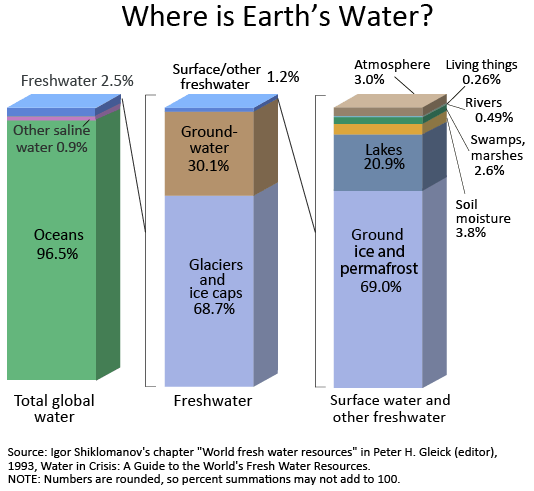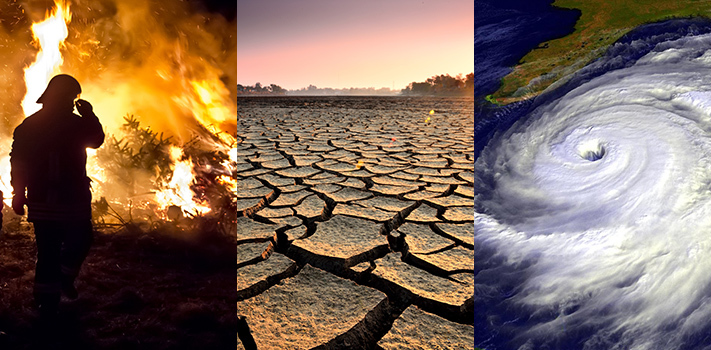


Food production has affected the environment more than any other activity humans have engaged in. Humanity devotes more land to food production than anything else – roughly a third of the surface area of the earth, much of which was once forest but has been converted by humans into farms or grazing lands. Agriculture also contributes to a host of other environmental and resource challenges. Nitrogen runoff from fertilizer used on US farms in the Midwest has created an 8,000 square mile dead zone in the Gulf of Mexico, an area roughly the size of New Jersey. Runoffs of pesticides are the number one source of pollution in US lakes and rivers. Farm irrigation uses 70% of the world’s fresh water, a resource increasingly under pressure.
The most obvious way to grow more food is to turn more land over to the task. But that runs hard into another ecological problem: Deforestation.
In prehistoric times, roughly half of the earth’s land surface was forested. Today only half of that forest area remains, the rest having been converted into farm land and grazing land by human hands. And every year, the planet loses roughly another 50,000 square miles, an area roughly the size of Louisiana. Much of that is in the tropics. Since 1950, a full 60% of the world’s tropical rainforests have been destroyed.

Nevertheless, those forests are the most obvious place to expand farming into. The rest of the land on the surface of the planet is either already farmed; is covered in desert, mountain, or swamps; or is used up by cities and towns. And indeed, in the tropics, agriculture is the #1 contributor to deforestation, accounting for an estimated 80% of the forest chopped down.
The planet’s forests are, as The Economist called them, the world’s lungs. They consume CO2 from the atmosphere, converting it into wood and leaf. The world’s forests contain around one trillion tons of carbon (or 3.7 trillion tons of CO2) – equivalent to nearly a century of human emissions. They emit a quarter of the oxygen that feeds all other animal life on earth, including humans. They provide a safe haven for millions of species found nowhere else. The rain forests alone are estimated to contain 75% of the biodiversity found on land. Forests keep topsoil in place that would otherwise fly away. (Sadly, when topsoil that was once forest blows away, forests suffer, as bordering farmers chop more of it down to acquire more land to make up for the drop in productivity of their current lands.) And, through a process called evapotranspiration, forests bring rain to areas downwind of them. Tropical rainforests alone produce around 20% of the world’s oxygen and 30% of the world’s fresh water. Human activity that damages them has wide reaching effects.
Feeding the growing appetite of humanity by simply farming more land simply isn’t an option – unless we want to accept the release of hundreds of billions of tons of CO2, the disruption of local precipitation patterns, and the extinction of hundreds of thousands of species as an acceptable loss.
To preserve our remaining forests, we’re going to need to grow more food without farming more land.
Farming (and to a lesser extent, other human activities) are also placing a huge stress on fresh water supplies. Water is life. Agriculture depends upon it. Nearly 70% of the water humanity uses is for irrigation. Growing food for an average human diet requires an estimated 320 gallons of water a day. For an average American diet the number is closer to 900 gallons of water a day. To produce that water, we’re drawing down rivers, lakes, and fossil water aquifers at an unsustainable rate.
Beneath the American high plains of Nebraska, Kansas, northern Texas, and five other states lies the Ogallala Aquifer, a giant underground reservoir of fresh water that farms and people in the region depend on. Ogallala is full of ‘fossil water’ – the remnants of the glaciers and ice sheets that retreated from this area more than 10,000 years ago, melting and filling underwater basins as they went. That fossil water is used to irrigate 27% of the farmland in the United States.

Ogallala’s water level is dropping, in some places as fast as three feet per year. In two months the water we withdraw from Ogallala is enough to fill a cube a mile on a side, enough to cover every inch of the island of Manhattan in more than 200 feet of standing water.
Water is abundant on our planet. Oceans cover 70% of the Earth’s surface. Their combined volume is huge. Even freshwater is vast in quantity. It literally falls from the sky.
Yet the rate at which we consume water – particularly for agriculture - exceeds the rate at which we can capture it from rain or from sustainable withdrawals from rivers. To feed our planet, we’ve turned to more extreme methods, draining some rivers dry, and pumping water out of aquifers that will take thousands of years – if not longer – to refill once we’re done with them.
The Indus River Valley aquifer under India’s breadbasket is being drained at a rate of 20 cubic kilometers a year. Water tables in Gujarat province are falling by as much as 20 feet a year. The giant North China Plain aquifer, which provides irrigation for fields that feed hundreds of millions, has been found to drop as much as 10 feet in a single year. A World Bank report cautions that in some places in northern China, wells have to be drilled nearly half a mile deep to find fresh water. Hebei province, one of five atop the aquifer, has seen more than 900 of its 1,052 lakes dry up and disappear due to dropping water tables. In Mexico’s agricultural state of Guanajuato, the water table is dropping by 6 feet a year. In north eastern Iran, it’s dropping by as much as 10 feet a year.
Water is being withdrawn from rivers as well. Seasonal water levels are dropping on China’s Yellow River, on the Nile in Egypt, on the Indus as far north as Pakistan, and on the Rio Grande in the US. Parts of the Colorado River are a stunning 130 feet below their historic levels. The river no longer reaches the sea. Nor does the Yellow River or dozens of others around the world that have been tapped for irrigation. The rivers that flow through Central Asia have been so massively drained for agriculture that the vast Aral Sea they once fed, once the fourth largest freshwater lake in the world, is now little more than a dry, salty lakebed, its former shore dotted with abandoned fishing villages and the bones of beached boats.
On current course and speed, the Ogallala aquifer will run dry before this century is over, and possibly much sooner. The North China Plain aquifer will run dry. The Indus River Valley aquifer will run dry. And when they do, the cost to agriculture – and thus to human life – will be enormous.
In the oceans, the situation is nearly as dire. Fish are an essential human food source. Worldwide, they provide 16% of the protein humans consume. In Africa, they provide 21%. In Asia, a whopping 28%. In some individual countries, fish are even more vital. Fish provide 65% of the protein available in Ghana, 58% of the protein available in Indonesia, and 50% of the protein available in Bangladesh. Worldwide, a billion people rely on fish as their primary protein source.

Yet even renewable resources have their limits. When hunted too rapidly, fish populations can collapse. The number of adult breeders that remain can be too low to rebuild the population as they deal with predators, with competitor species, and with the continued pressure of human fishing. That sort of collapse has happened again and again in recent years, with disastrous impacts for both fish species and humans.
Today, the Food and Agriculture Organization of the UN estimates that a third of fish species have either crashed already or are overexploited and pushed to the edge. Another half of all fish species are fully exploited, with no room to grow production. If the demand for fish continues to grow at or near past rates, the FAO believes global fisheries could completely collapse by 2050.
If we want to keep eating fish for the rest of this century, we need to find a better way to acquire them.
Then there is the problem that exacerbates all others.
Our planet is warming. CO2 and other greenhouse gases released by our relentless burning of fossil fuels, our deforestation of the planet, and our livestock are accumulating in the atmosphere. Those gases, in turn, are trapping more heat that would otherwise have escaped into space.
The evidence is all around us. In 1850, Glacier National Park was home to 150 active glaciers. Today it has 25. By 2030 they could all be gone. Mt. Kilimanjaro, the highest peak in Africa, was covered a century ago by twenty square kilometers of glacier. Today it’s covered by less than three. Permafrost in the northen lattitudes is melting so badly that residents of at least four Alaskan villages are trying to relocate their entire towns to firmer ground.
And perhaps most dramatically, the Arctic ice cap is melting rapidly. In 1980, the smallest area covered by Arctic ice in summer was 8 million square kilometers. In September 2012 it was down to 3.4 million square kilometers. With the ice half as thick as it once was, the ice cap’s volume is barely a quarter of what it was thirty years ago. As recently as 2007, the IPCC predicted that ice-free Arctic summer days wouldn’t arrive until the middle of the 21st century, more than 130 years in the future. Now there’s the very real risk that we’ll see those first ice-free summer days by the end of this decade – more than a hundred years ahead of schedule.
The most commonly discussed impact of climate change is rising sea levels. And indeed, climate change is expected to raise global sea levels by 3 to 6 feet by the end of the century, not enough to drown the Statue of Liberty, but enough to put dozens of coastal cities and island nations at risk.
Yet there are other risks not so far in the future. Indeed, they’re here now.
In 2003, Europe went through its hottest summer on record since at least 1540. An estimated 70,000 people died from the heat wave. Fires destroyed 10% of the forests of Portugal. France lost 20% of its wheat harvest. Ukraine lost a whopping 75%.
Since then, record droughts hit China in 2009 and 2010, wiping out nearly half the winter wheat harvest, leaving 20 million people without adequate drinking water, and drying up wells that had provided water since 1517.
Climate change causes drought by increasing the moisture demand of the atmosphere. Every degree Celsius of warming increases the amount of water the air can hold by around 7%. But that moisture isn’t distributed evenly. Warmer air can whisk huge volumes of water away from one place, and bring it down in a sudden deluge in another.
And so, in May 2010, China also saw epic floods that killed more than 3,000 people, destroyed 1 million homes, and forced the evacuation of 15 million more.
In August of 2010, another heat wave struck Russia, setting record highs of 111 degrees Fahrenheit and killing 55,000 people across the country in just two months. In Moscow alone, 11,000 people died as a result of the heat.
And the US hasn’t been immune to the effects either. In 2012, the combination of Hurricane Sandy and devastating drought across the American South and Midwest inflicted a combined $100 billion in damage to the US. The drought alone wiped out a quarter of the US corn crop. And that drought, which began in 2011, shows no signs of abetting. Conditions this year, in the spring of 2013, are drier than they were in the spring of 2012.
It’s impossible to attribute a single, specific extreme weather event to climate change. Even if CO2 levels had never risen on Earth, some extreme weather events would occur. But it’s clear that extreme weather is becoming more common as the planet warms, just as models predict.

Heat waves are the clearest example. Record highs are now twice as common as record lows. But both record highs and record lows are now more common, as a warmer, more energetic atmosphere can move masses of air around more rapidly. And peer-reviewed studies have now shown that the deadly heat waves and droughts I’ve just mentioned – Europe in 2003, Russia in 2010, the US South and Midwest since 2011 - were all made many times more likely by climate change.
What will happen if the planet warms as expected on the business-as-usual path? Climate simulations show decade long dustbowls in the US, Africa, China, and parts of Europe, combined with torrential rains and monsoons in other areas, stronger and more frequent hurricanes in the Atlantic, and incredible periodic heat waves over much of the world.
Climate change makes every other environmental problem worse. Drought has already taken its toll on the Amazon and other tropical forests. Heat and drought accelerate fresh water loss. Heat, drought, and extreme weather have decimated crops and threaten to do much worse in the future, making it that much harder to feed the population. And the other big effect of CO2 emissions release, ocean acidification, threatens the corals that are essential to the ocean food web - a food web already under pressure from human overfishing.